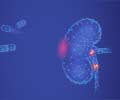In the past decade, nanomedicine has contributed to improved discovery and treatment of cancer. Nanoparticles are several 100 times smaller than the smallest grain of sand and can, so, easily travel in the bloodstream to arrive at the tumor.

‘Nanoparticles are several 100 times smaller than the smallest grain of sand and can therefore easily travel in the blood stream to reach the tumor.’





Using a real-time imaging technique, which they have established in their laboratory, the team investigated in a mouse model the fate of these nanoparticles. They observed that the polysaccharide-enriched nanoparticles readily pass through the kidney and are excreted with the urine within a few hours after intravenous administration. The decisive factor for the researchers was that the nanoparticles continued to act as intended and were still able to target tumors."The ability to combine tumor accumulation and kidney clearance in the same nanoparticle represents a tipping point in ensuring that nanomedicines can be safely administered" says Shastri. "Our nature-inspired approach enabled us to trick the kidney environment to let nanoparticles pass through" adds Dr. Melika Sarem who was a co-author of the study.
Source-Eurekalert







